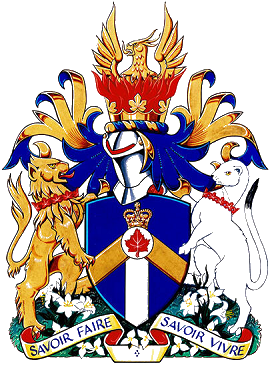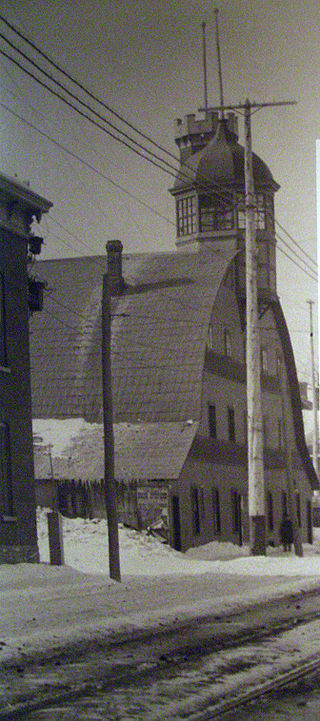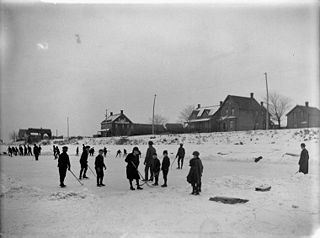
Sir Sandford Fleming was a Scottish Canadian engineer and inventor. Born and raised in Scotland, he emigrated to colonial Canada at the age of 18. He promoted worldwide standard time zones, a prime meridian, and use of the 24-hour clock as key elements to communicating the accurate time, all of which influenced the creation of Coordinated Universal Time. He designed Canada's first postage stamp, produced a great deal of work in the fields of land surveying and map making, engineered much of the Intercolonial Railway and the first several hundred kilometers of the Canadian Pacific Railway, and was a founding member of the Royal Society of Canada and founder of the Canadian Institute.
Bytown is the former name of Ottawa, Ontario, Canada. It was founded on September 26, 1826, incorporated as a town on January 1, 1850, and superseded by the incorporation of the City of Ottawa on January 1, 1855. The founding was marked by a sod turning, and a letter from Governor General Dalhousie which authorized Lieutenant Colonel John By to divide up the town into lots. Bytown came about as a result of the construction of the Rideau Canal and grew largely due to the Ottawa River timber trade. Bytown's first mayor was John Scott, elected in 1847.

Winterlude is an annual winter festival held in Ottawa, Ontario and Gatineau, Quebec.

The Rideau Club is a private social club in Ottawa, Ontario. The club was founded in 1865 by Sir John A. Macdonald and Sir George-Étienne Cartier as a gentlemen's club, but since 1979 has been mixed-sex. For much of its history the club was populated primarily by parliamentarians. In 1876 the Rideau built its clubhouse at 84 Wellington Street, where it remained until the building burned down in 1979. Since the fire, the club has been located in the top floor of the Metropolitan Life Building at 99 Bank Street.

TD Place Arena, originally the Ottawa Civic Centre, is an indoor arena located in Ottawa, Ontario, Canada, seating 6,500 people. With temporary seating and standing room it can hold 8,000 people. Opened in December 1967, it is used primarily for sports, including curling, figure skating, ice hockey and lacrosse. The arena has hosted Canadian and world championships in figure skating and ice hockey, including the first women's world ice hockey championship in 1990. Canadian championships in curling have also been hosted at the arena. It is also used for concerts and conventions such as Ottawa SuperEX.

The Centre for Geography and Exploration, located at 50 Sussex Drive in Ottawa, is headquarters to the Royal Canadian Geographical Society (RCGS) and home to Canadian Geographic magazine, as well as Can Geo Education and special project departments.

Lansdowne Park is a 40-acre (16 ha) urban park, historic sports, exhibition and entertainment facility in Ottawa, Ontario, Canada, owned by the City of Ottawa. It is located on Bank Street adjacent to the Rideau Canal in The Glebe neighbourhood of central Ottawa. Lansdowne Park contains the TD Place Stadium and Arena complex, the Aberdeen Pavilion, and the Horticulture Building.

Major's Hill Park is a park in downtown Ottawa, Ontario. The park stands above the Rideau Canal at the point where it enters the Ottawa River. The parliament buildings can be seen across the canal to the west, to the north of the park is the National Gallery of Canada, and to the east are the United States embassy and the Byward Market. To the south is the Chateau Laurier hotel, built on land that was once part of the park.

The Senate of Canada Building is a government building and former railway station that serves as the temporary seat of the Senate of Canada. Located at 2 Rideau Street in downtown Ottawa, it was known as Ottawa Union Station and served as the city's central railway station from 1912 until 1966. From 1966 to 2018, it was operated by the Government of Canada as the Government Conference Centre. The building currently includes a temporary Senate chamber, as well as some Senate offices and committee rooms.

The Ottawa Curling Club is an historic curling club located on O'Connor Street in the Centretown neighbourhood of Ottawa, Ontario, Canada. It is the oldest curling club in Ottawa, established in 1851 by Allan Gilmour as the Bytown Curling Club. The Club first played on the Rideau Canal until 1858. It subsequently moved to different locations around the city until finally settling at its current location on O'Connor in 1916. In 1931 the club was expanded to the current capacity of 5 curling sheets. Artificial ice was also installed at that time.

St. Bartholomew's Anglican Church is a place of worship in Ottawa, Ontario, Canada. The building was constructed in the latter half of the 19th century and serves the surrounding neighbourhoods. Additionally, St. Bartholomew's is, due to its location next to Rideau Hall, the place of worship for various Governors General of Canada and some members of the Canadian Royal Family. It is also the regimental chapel of the Governor General's Foot Guards.

The Transportation Building, 10 Rideau Street, Ottawa, Ontario, Canada is a historic Gothic revival/Chicago school office tower. The building stands at the intersection of Sussex Drive and Rideau Street.

The Bytown Museum is a museum in Ottawa located in the Colonel By Valley at the Ottawa Locks of the Rideau Canal at the Ottawa River, just below Parliament Hill. Housed in the Commissariat Building, Ottawa's oldest remaining stone building, the museum provides a comprehensive overview of the origins of Bytown and its development and growth into the present city of Ottawa.

Murphy-Gamble Limited was a long-time department store in the City of Ottawa, Ontario, Canada.

Metcalfe is a population centre located in Osgoode Ward, in the rural south-end of the city of Ottawa, Ontario, Canada. Prior to amalgamation in 2001, the community was in Osgoode Township. According to the Canada 2016 Census, it has a population of 1,776.
Dey's Arena, also known as Dey Brothers Rink, Dey's Skating Rink and The Arena, were a series of ice rinks and arenas located in Ottawa, Ontario, that hold importance in the early development of the organized sport of ice hockey in Canada. It was the home arena of the Ottawa Hockey Club, variously known as the Generals, the Silver Seven and the Senators from the 1890s until 1923, although it is known that games were also played at the Rideau Skating Rink in the 1890s and the Aberdeen Pavilion in 1904. The rink and arenas were built by two generations of the Dey family, who were prominent in Ottawa at the time, with a thriving boat works business serving the lumber business. The Dey family also played hockey.

The Rideau Skating Rink was an indoor skating and curling facility located in Ottawa, Ontario, Canada. Consisting of a curling rink and a skating rink, it was one of the first indoor rinks in Canada. The Rideau Rink was scheduled to open on January 10, 1889, but unseasonably mild weather postponed the grand opening to February 1. It opened on January 25, 1889 for select V.I.P.s although this was a misunderstanding and should not have denied entry to season ticket holders. It was located on Theodore Street, at Waller Street, at the present location of the Arts Hall of the University of Ottawa, near the Rideau Canal.

Frank Maurice Stinson Jenkins was an early amateur ice hockey player. He was a founder, and the first captain of the Ottawa Hockey Club of 1883. He was also the founder in 1894 of Ottawa's first full-size orchestra, the Ottawa Amateur Orchestral Society.
The Minto Skating Club is a competitive figure skating club in Ottawa, Ontario, Canada, founded in 1904. The Club is a member of the Skate Canada figure skating organization in Canada, and was a founder of the predecessor organization to Skate Canada, the "Figure Skating Department" of the Amateur Skating Association of Canada in 1914.

Sport in Ottawa, Canada's capital, has a history dating back to the 19th century. Ottawa is now home to five professional sports teams: the Ottawa Senators of the National Hockey League; the Ottawa Redblacks of the Canadian Football League; the Ottawa Titans of the Frontier League; the Ottawa Blackjacks of the Canadian Elite Basketball League; and Atlético Ottawa of the Canadian Premier League. Several non-professional teams also play in Ottawa, including the Ottawa 67's junior hockey team and other semi-professional and collegiate teams in various sports.
















